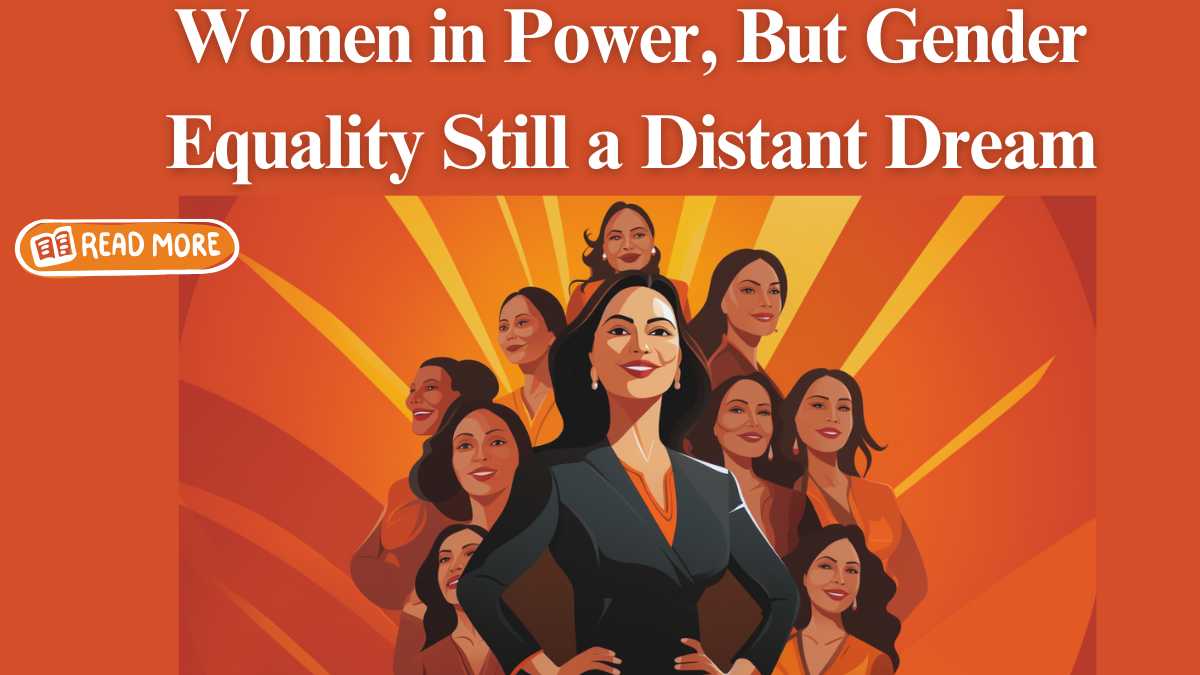Many countries have had powerful women leaders, such as India’s Indira Gandhi, Pakistan’s Benazir Bhutto, and Germany’s Angela Merkel. These women are seen as symbols of progress and achievement. But does having women in power really lead to gender equality? The answer is not as straightforward as it seems. Despite these women’s leadership, gender inequality continues to persist in many areas, even in their own countries. Let’s explore why.

Why Having Women in Power Doesn’t Guarantee Equality
Having a woman in power, like a prime minister or president, might seem like a sign that society is moving towards gender equality. However, even in countries led by women, gender equality often does not improve across the board.
For example, while Indira Gandhi was the first female Prime Minister of India, gender discrimination and inequality still exist in India today. Women face challenges such as limited access to education, lower-paying jobs, and a lack of safety in public spaces.
In Pakistan, despite Benazir Bhutto’s leadership as the first woman to head a Muslim-majority country, many women still face issues like domestic violence, early marriages, and limited career opportunities.
Even in Germany, where Angela Merkel served as Chancellor for many years, women still earn less than men and are underrepresented in top political and business roles.
Why Patriarchy Still Holds Power
A key reason why gender equality doesn’t always follow the election of a female leader is the deep-rooted patriarchy that exists in many cultures. Patriarchy is a system where men hold most of the power, and women’s roles are limited to specific expectations, like taking care of the home and children.
Even when a woman becomes a leader, she is often working within these deeply embedded systems. She might not have the power to change the societal structures that hold women back. Many times, women in power have to work harder to prove themselves, which can limit their ability to make widespread changes for gender equality.
Gender Inequality Goes Beyond Politics
Gender inequality is not just about politics. Even though a woman may be leading a country, this does not automatically change the experiences of everyday women. For example, in many countries, women continue to face inequality at home, in the workplace, and in their communities.
Despite having powerful female leaders, the pressure of traditional gender roles remains. Women are often expected to be both successful leaders and fulfill traditional roles like caregiving and homemaking, which can create a conflict between these responsibilities.
Additionally, women in leadership positions are often held to higher standards than men, making it harder for them to challenge traditional gender norms or policies that don’t support gender equality.
True Equality Takes More Than a Female Leader
Gender equality cannot be achieved just by electing women to power. While it’s important to have women in leadership roles, real change comes from making systemic changes to society. This means improving the conditions for all women, not just those who make it to top political positions.
Key areas that need to change include:
- Education: Ensuring all girls and women have access to quality education.
- Workplace Equality: Offering equal pay, job opportunities, and career growth for women.
- Legal Protection: Strengthening laws to protect women from violence and discrimination.
- Changing Cultural Norms: Encouraging both men and women to challenge traditional gender roles and expectations.
The Role of Men in Gender Equality
Gender equality isn’t just a women’s issue. It requires the active involvement of men, too. Men must play a role in supporting gender equality by challenging stereotypes, supporting women’s rights, and sharing household and caregiving responsibilities. True gender equality happens when both men and women work together to break down barriers.
Conclusion
Having women in power, like Indira Gandhi, Benazir Bhutto, and Angela Merkel, is a huge achievement and represents progress in many ways. However, gender equality is not just about having a female leader. It requires cultural changes, legal reforms, and societal shifts.
To create true equality, we need to focus on improving the lives of all women, whether they are in leadership or not. It’s about creating equal opportunities for women and men, both in public and private life. Gender equality is a collective effort, and it will take time and collaboration to achieve.
FAQ
1. Does having a woman in power guarantee gender equality?
No, having a woman in power does not guarantee gender equality. Even with women in leadership, deeply rooted societal and cultural barriers still affect women’s rights and opportunities.
2. Why does patriarchy still exist despite having female leaders?
Patriarchy is a long-standing societal structure that persists even when women hold power. Cultural norms and gender roles are hard to change, and they continue to limit women’s freedoms and opportunities.
3. What are some examples of gender inequality despite female leadership?
Even with female leaders like Indira Gandhi, Benazir Bhutto, and Angela Merkel, women still face unequal pay, limited access to leadership roles, and gender-based violence, showing that leadership alone doesn’t ensure equality.
4. What needs to change to achieve true gender equality?
To achieve true equality, changes are needed in education, pay, legal protections, and societal attitudes towards gender roles. These systemic shifts will help ensure women have the same opportunities as men.
5. How can men contribute to gender equality?
Men can support gender equality by challenging stereotypes, promoting equal opportunities, sharing household responsibilities, and standing up against gender-based discrimination.
Click here to learn more.
Pari is a passionate writer known for captivating stories that blend imagination and reality. Inspired by travel, history, and everyday moments, Pari crafts narratives that resonate deeply with readers.